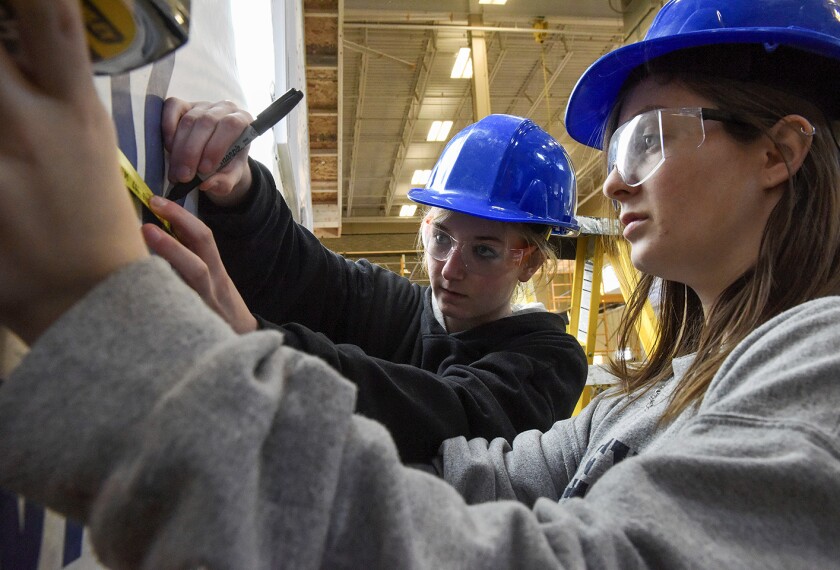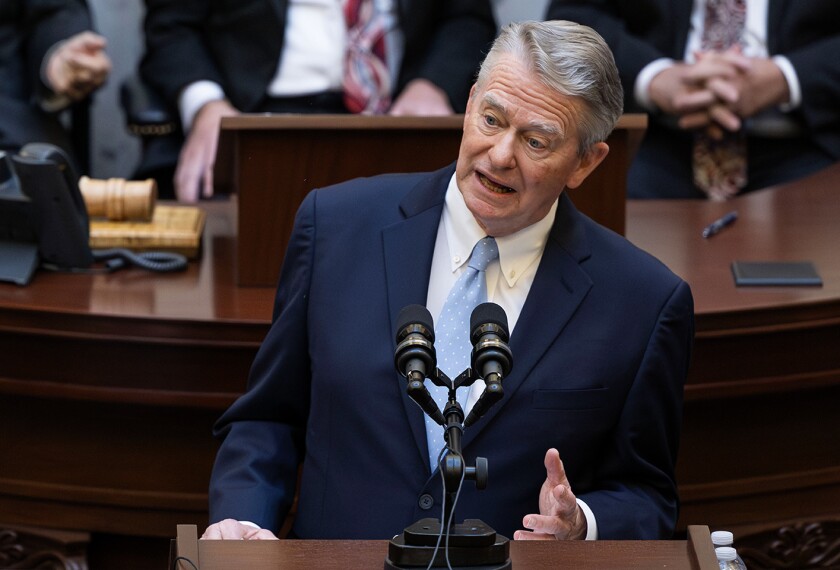Across the nation, differing visions of how and when to reopen school buildings that were closed—many for the rest of the school year—to slow the spread of the coronavirus are creating tension among local, state, and federal officials.
While President Donald Trump casts an ambitious goal of “reopening the country” in early May, some of his own federal agencies say getting the economy back up to speed is closely linked to having schools safely open their doors, freeing up parents to re-enter the workforce.
At the same time, 25 states and three U.S. territories have ordered or recommended school building closures for the rest of the academic year, well beyond Trump’s May 1 target, according to Education Week’s tracker. And, even in states that have not made such a decision, state school chiefs planning for students’ eventual return have warned that schools may have to close again in the fall if the pandemic resurges.
“There is no research and there is no best practice for this kind of mass extended closure,” said Stephen Pruitt, the president of the Southern Regional Education Board and a former education commissioner in Kentucky. “This is going to be new for everyone.”
Governors—working alone or in cooperation with newly created multistate consortia—are considering a variety of factors as they determine when to ease their stay-home directives in general and when to reopen schools.
Those factors include whether public health officials can effectively track the spread of the virus to allow for more targeted mitigation efforts; whether hospitals are prepared and equipped to treat patients; and what modifications schools should make to their operations to allow for social distancing in classrooms.
“There’s no light switch here. I would argue it’s more like a dimmer,” California Gov. Gavin Newsom, a Democrat, said at a news conference April 14. “This is an imperfect science. There is no playbook that someone else has put together.”
California’s governor and state superintendent have recommended that schools remain closed for the rest of the academic year, although the decision is up to individual districts in that state.
Newsom unveiled criteria he would consider before modifying the state’s stay-home order, which has no set end date. He said that when schools reopen, they may have to alter activities that lead to large clusters of students, like physical education classes and lunch service. And schools and businesses will need plans to screen visitors and employees for potential illness, he said.
Newsom spoke the day after he and the governors of Washington and Oregon announced a pact to coordinate plans to reopen schools and businesses.
That same day, seven northeastern states—New York, New Jersey, Connecticut, Rhode Island, Massachusetts, Pennsylvania, and Delaware—announced a similar regional agreement. Governors of those states plan to form a council made up of health and economic experts to guide their reopening plans. Among those states, Pennsylvania has already ordered its schools closed for the remainder of the school year.
New York Gov. Andrew Cuomo, a Democrat, also rejected the idea that the economy of a state could be restarted “like flipping a light switch.” He presented a graphic at a news conference Tuesday that showed schools, businesses, transportation, and health care working together like interconnected gears.
Cuomo had spent the weekend sparring with New York City Mayor Bill de Blasio, who made the independent decision to keep buildings in the nation’s largest school system closed for the remainder of the year. New York City schools are under mayoral control.
The decision about when and how to reopen schools must be made in collaboration with other leaders in the region, said Cuomo, who has ordered all schools in the state, including those in New York City, to close until the end of April. As New York has become the epicenter of the pandemic in the U.S., adjoining states like Connecticut have also seen surges.
“When we made the decision to close the schools, we made it for the entire region,” Cuomo said at his Saturday press briefing. “Any decision to reopen them will also be a coordinated decision.”
State-Federal Sparring
Sparring between state and local leaders mirrors emerging tensions between governors and Trump as he pushes to “reopen the economy” as early as May 1.
Trump said at an April 10 White House briefing that he has the power to override governors on their decisions about school closures, but he would rather not use that authority. His answer came in response to a question a reporter asked the president about a report that Florida Gov. Ron DeSantis, a Republican and Trump ally, is considering reopening schools in May.
This week, Trump has made assertions in the opposite direction, suggested he has “absolute authority” to reopen states’ businesses and schools, even if their governors want them to remain closed.
“The federal government has absolute power. It has the power,” Trump said Monday. “As to whether or not I’ll use that power, we’ll see.”
The comment led to rebukes from state leaders and concerns from legal analysts about a violation of states’ authority.
Trump announced a “reopening the country” council Tuesday to advise him on easing social distancing efforts. The list of participants includes hundreds of leaders from business, technology, health care, agriculture, and sports, but it does not include anyone from the education sector.
That’s despite the important role schools play in charting a path forward.
“The first priority is to reopen community settings where children are cared for, including K-12 schools, day cares, and locally attended summer camps, to allow the workforce to return to work,” says a draft document created by officials at the Federal Emergency Management Agency and the Centers for Disease Control and Prevention. “Other community settings will follow with careful monitoring for increased transmission that exceeds the public health and health care systems.”
That document, published by the Washington Post Tuesday, also proposes “grants for school districts to train teachers over summer break to develop curricula and teaching methods appropriate for periods of school closure,” suggesting that schools may have additional closures in the future.
It proposes a “staged reopening” process with a time frame that would be adjusted depending on local conditions.
“Models indicate 30-day shelter in place followed by 180-day lifting of all mitigation results in large rebound curve – some level of mitigation will be needed until vaccines or broad community immunity is achieved for recovering communities,” the document says.
States’ Roles
While federal agencies have issued guidelines about issues like crowd size, Trump has not made any federal orders regarding the closures of schools and businesses. And authority over schools largely rests with governors.
The wave of school closures that started on a district-by-district basis when the virus first emerged in the United States quickly picked up speed as governors issued statewide orders throughout March, and it will be up to governors to lift those orders, they say.
In Maryland, where state leaders are constantly revisiting their timeline for reopening, state education officials are preparing for the possibility of further periods of remote learning in the fall, State Superintendent of Schools Karen Salmon said April 8.
“I’m not sure we are going to be doing school in the same way going forward,” she said, echoing a similar caution by leaders in Washington State.
Maryland has seen significant spread of the coronavirus in Baltimore and counties that are part of suburban Washington, D.C. The state, like others around the country, is working on a system for “contact tracing” that will allow public health officials to quickly identify and isolate people who catch the virus and anyone who may have been exposed through interactions with them.
But health officials around the country have warned that shortages of tests and related supplies might throw sand in the gears of those efforts. A study by researchers at Johns Hopkins University estimates it could take 100,000 public health officials nationwide to effectively trace the virus and slow its spread.
How Will Schools Reopen?
Even as state and national leaders, and the public, continue to debate when schools will reopen, education leaders are focusing their discussions on what it will look like when they do.
“We’ve got to provide better support, better guidance, better [professional development], better everything than we’ve always done,” said Pruitt of the Southern Regional Education Board. “We can’t go into August hoping things will be like they’ve always been because they will not. Hope is not a strategy.”
The SREB’s 16 member states announced Wednesday plans to create an “education recovery task force” that will be co-chaired by Pruitt and Virginia State Superintendent James Lane.
The group, which will meet for the first time next week, plans to make a road map for how schools can restart in-person instruction when they get the green light from health and government officials.
Among the areas they will address: how to effectively spend federal recovery dollars targeted at schools; how to recruit educators to meet new learning needs students may have after being away from school; how to prepare for possible future closures; and how to assess and meet the emotional and academic needs of students who may have had limited or insufficient exposure to remote learning opportunities.
“These are real gaps where students may not have even been exposed to the instruction that we expect in a school year,” Lane said, adding that the task force would pay particular mind to the needs of English-language learners, students with disabilities, and students in poverty.
Around the country, schools are also facing logistical questions about how to space students in cafeterias to avoid crowding, whether to rearrange bus routes to transport smaller groups of students, and how to compensate for lost learning time. They are also discussing how to confront other disasters, like tornados, that may occur as schools continue to face the fallout of the pandemic, Pruitt said.
And they are facing those questions under the threat of cratered state funding during a national economic crisis, Lane said.
“I’m not sure everyone understands the balance that states and superintendents are going to have to do in order to be able to address these things,” he said.
Many of the states involved in the collaborative, including Virginia, have already ended in-person instruction for the remainder of the school year.
Will any others reopen buildings before then?
“I think that’s getting more and more unlikely,” Pruitt said.






